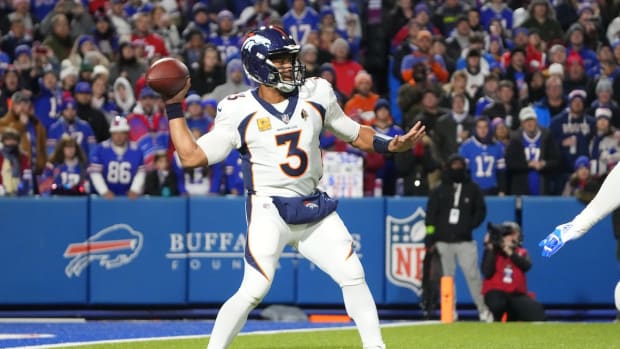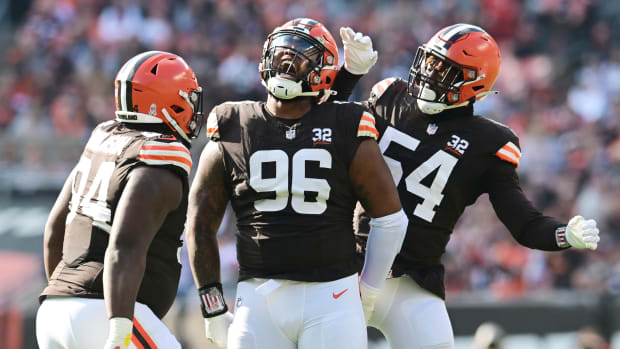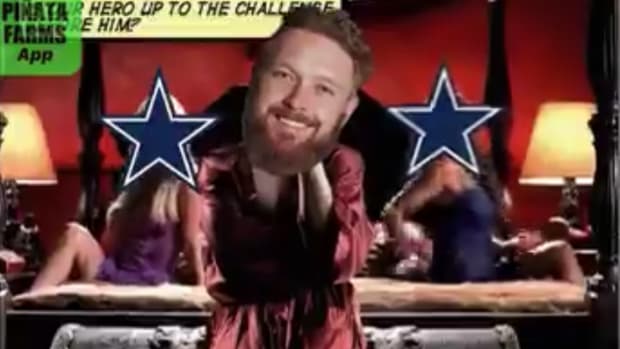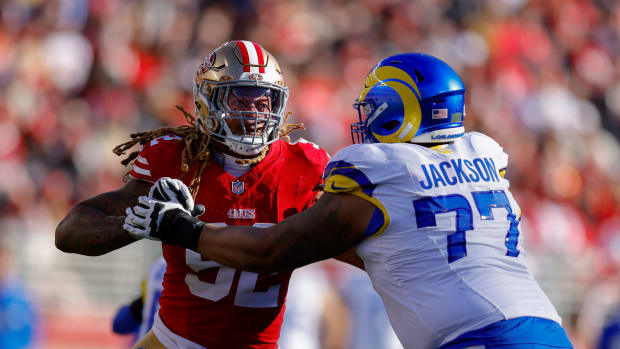Draft Day 2 Analysis: The Browns Play It Smart
America entered draft week ready to blast the Browns for overextending to go get a quarterback in a year with no sure thing at the position—and in the process, passing on a pass-rusher with a comic-book build and Olympic athleticism.
We’ll exit it having seen Cleveland do the opposite.
The Browns didn’t draft Mitchell Trubisky over Myles Garrett after all. They didn’t make a huge move up the board from 12 to get the North Carolina QB/local native either. They actually traded out, then traded up, augmenting the roster with the above freak, Myles Garrett, and two raw/talented prospects on Thursday.
And just when you thought that was it, the Browns made their quarterback news by catching another Ohioan’s fall on Friday. Questions about Notre Dame QB DeShone Kizer’s mental makeup and ability to deal with adversity dogged his pre-draft process and made his availability on Day 2 expected. What fewer forecast was that Kizer’s plummet would last more 20 picks.
So the Browns basically punt on this year’s quarterback class, and come away with arguably the most physically gifted guy in the bunch. If Kizer—thought to be a potential top-five pick early in the fall—works out, great. If not, they didn’t exactly blow up the treasure trove of capital they’ve built, which seemed to be the idea as Cleveland adjusted to making a QB its fourth pick, rather than its first or second.
• CHICAGO’S QB SHUFFLE: Jenny Vrentas on what was behind the Bears’ move for Mitch Trubisky
“That’s probably fair,” Browns EVP of football operations Sashi Brown said, driving home around midnight. “There are a couple things there. One, our roster, in our view, demands some attention. So we don’t really have the luxury to bundle a whole bunch of picks to go get a guy, or pass up on the opportunity to acquire a bunch of picks. The second thing, we don’t necessarily want to force it.”
There’s the key.
Just look at what Brown and coach Hue Jackson have done at the quarterback position in two offseasons. They paid Robert Griffin ($7.5 million) and Josh McCown ($4.4 million) last year, and drafted Cody Kessler in the third round. This time around they have Kessler back with waiver-wire addition Kevin Hogan; salary dumpee Brock Osweiler (they got a 2018 second-rounder to carry his $16 million); and now Kizer.
They haven’t swung for the fences yet. Maybe Kizer or even Kessler develops into the future. Maybe not. The important thing, as they see it, is using resources to get the roster to a place where, if they do take that big cut, the environment that quarterback is walking into isn’t the impossible one that McCown, Griffin and Kessler operated under during the 2016 season.
“That’s absolutely right,” Brown said. “In terms of sequencing, you want to make sure that when you have a quarterback, particularly a young quarterback, he’s got the best opportunity to be successful as possible. To put it frankly, we didn’t think we were in that position coming out of 2015. We’re getting closer to that. We’ve got a ways to go.
“So we had the opportunity to add DeShone here. And we still need to do some work on our roster, and to improve the culture of our building. He’ll be a piece of that.”
How big a piece remains to be seen. Based the reporting I’ve done on the kid, it’s clear Kizer has some growing up to do, and it’s easy to see where Jackson’s tough-love style could do him a lot of good in that regard. His recent comments to USA Today, in which he elicited the names of Cam Newton and Tom Brady, didn’t help quell concerns over his maturity, nor did it level off the idea that he’s had a big head.
• THE RAIDERS GAMBLE ON GAREON CONLEY: Peter King on Oakland’s move for a cornerback under a cloud
The flip side is how Brown describes his new rookie—“a big, talented, athletic, bright, competitive and motivated quarterback who’s very young. I think his best football’s ahead of him.”
What becomes of him now is really anyone’s guess. Kizer went 4-8 last year at Notre Dame, and didn’t handle adversity well in the process. All of that explains why now an NFL team is taking a flyer on him rather than selling the farm for him. Kizer will get his shot to compete. The Browns get to keep their options open.
“We do want to be mindful of just not forcing a guy because we don’t have a [long-term] quarterback,” Brown said. “So the notion, if you don’t have a quarterback, you have to take one high, we don’t want to get into that. And this is actually a pretty high pick for one. We just had the luxury to be able to add some other talent along with DeShone, and that’s a nice combination for us.”
It wasn’t the outcome Kizer was looking for. And in an ideal world, the Browns probably would have gotten both Garrett and Trubisky.
Now? Kizer gets a year to establish himself as part of the future, and Brown and Jackson can give him that shot without costing themselves another one next offseason, when Jimmy Garoppolo, Kirk Cousins and an expected bumper crop in the draft are there for everyone.
• ROUND 1 ANALYSIS, MINUS THE POINTLESS GRADES: Andy Benoit’s pick-by-pick look at the first round
As for what else happened Friday …
Five Quick Hitters from Day 2
1. Running back risks. Plenty of teams take their risks in the second round, and the first one on Friday night came when the Vikings dealt up from 48 to 41 to get Florida State dynamo Dalvin Cook. And Minnesota is probably the right landing spot for the star-crossed Seminole—it’s far from his home back in Miami, and he’s the kind of kid who will benefit from leaving the old neighborhood behind. Plus, one rival coach affirmed that, because of his versatility, Cook is a better scheme fit for Minnesota offensive coordinator Pat Shurmur than Adrian Peterson was. “He fits all the West Coast stuff.”
• DALVIN COOK’S RED FLAGS: Robert Klemko on the FSU back’s past
And yet, the more noteworthy Round 2 risk came from the other end of that trade—when the Bengals took Joe Mixon with the 48th overall pick. That this was on the table was an open secret in league circles. Cincinnati had Mixon ranked as the No. 2 back in this class, behind only Leonard Fournette, and it views his as a true rarity: A 230-pound back capable of pushing the pile in short-yardage, and flexing out on third down. “He’s a starting running back,” said one team source, “who could be your No. 3 receiver.”
2. We always talk about teams jumping back into the bottom of the first round to steal away quarterbacks. Know what? It doesn’t happen much. Over the last seven drafts, just four QBs have gone in the second half of the first round—Brandon Weeden, Johnny Manziel, Teddy Bridgewater and Paxton Lynch. More often than not, we see what we saw the last two days. Serious interest manifests itself at the top of the first round, and everyone else slips. In this case, Kizer to 52 and the Browns, Davis Webb to 87 and the Giants, and Nate Peterman out of the first three rounds all together.
3. There’s been a lot of talk about how the Redskins’ March divorce with Scot McCloughan would affect their preparation for this weekend. The answer appears to be that it didn’t really change anything. By any measure, the board fell in the team’s favor. Going back to January, the Redskins had first-round grades on Alabama’s Jonathan Allen (duh) and Ryan Anderson, whom they took with the 17th and 49th picks, respectively. The third of their selections, UCLA CB Fabian Moreau, rose a bit through the process, even while he was hurt, but carried a second-round grade and was always considered a top-five player in his loaded position group.
4. We’ve discussed the strength of this year’s defensive back group the last two months—and the numbers are backing it up. Through three rounds, 18 cornerbacks and 11 safeties have been drafted. That’s seven more defensive backs than there were in the first two days last year. And as we look forward to Saturday, the promise of unprecedented depth at corner and safety is visible. Three of ESPN’s top nine Best Available are DBs. One of those three, Iowa’s Desmond King, just happened to win the Thorpe Award last fall as the nation’s top college defensive back. Crazy.
• DRAFT TRACKER: Scouting report and player comps for every pick
5. And one last thing—How fun is the Panthers’ offense going to be to watch? They have the veritable basketball team along the line of scrimmage with Kelvin Benjamin, Greg Olsen and Devin Funchess, and then behind them Swiss Army knife rookies Christian McCaffrey and Curtis Samuel (who played the Percy Harvin role in Urban Meyer’s offense) operating in space. McCaffrey was one of the nation’s most versatile backs in 2016, and Samuel had twice as many receptions (74) as McCaffrey. Add it up, and Cam Newton gets some more easy completions, the Panthers get more diversity in the running game, and coordinator Mike Shula gets so much more room for creativity.
Question or comment? Email us at talkback@themmqb.com.




































